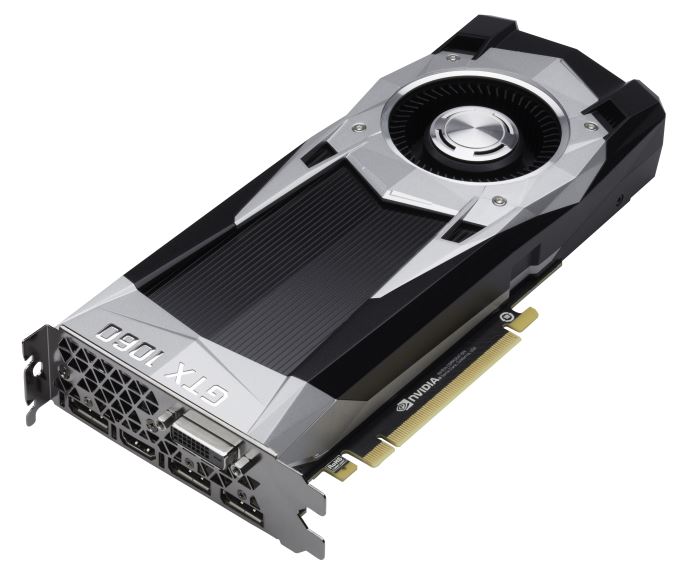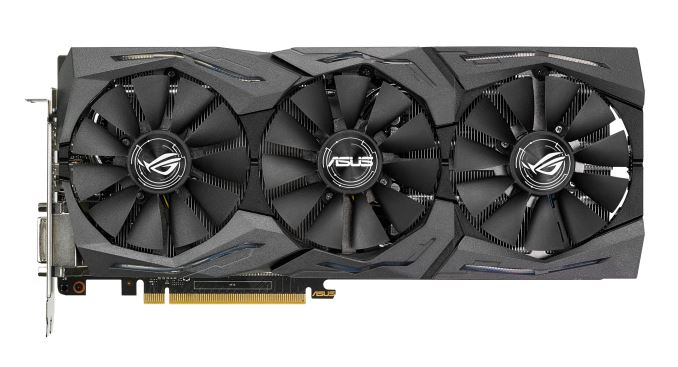The GeForce GTX 1060 Founders Edition & ASUS Strix GTX 1060 Review
by Ryan Smith on August 5, 2016 2:00 PM ESTFinal Words
Bringing this review to a close, while in the big picture we’re still early in the release cycle of the FinFET generation of video cards, the launch of the GeForce GTX 1060 and its underlying GP106 GPU none the less marks an important turning point in this release cycle. While NVIDIA and AMD were content to initially chase different markets with their respective first product releases – going after the high-end and mainstream markets respectively – now that NVIDIA is further fleshing out their product stack, NVIDIA and AMD can no longer avoid each other. So for the first time in this generation we have some real competition, and importantly for so many gamers out there it takes place in the higher volume mainstream market.
Overall, GeForce GTX 1060 follows a string of well executed NVIDIA launches throughout the Maxwell and now Pascal generations, and GTX 1060 is no different. NVIDIA has continued to focus on balancing performance with power consumption, and the end result is that like its bigger siblings, GP106 and GTX 1060 follow this trend to a T.
Relative to GeForce GTX 1070, GTX 1060 delivers 73% of the performance of NVIDIA’s enthusiast level card. In practice this puts GTX 1060 a bit closer to GTX 1070 than GTX 960 was to GTX 970 last year; the performance gap between these tiers is a bit narrower, likely as a result of the fact that the gap between GTX 1070 and GTX 1080 is greater. The end result, then is that GTX 1060 offers 73% of the performance for what’s (on paper) 66% of the price. Consequently, buyers looking for GTX 1060 to radically alter the price/performance curve of this generation may come away with less than they hoped for, but mainstream gamers looking for a cheaper Pascal card finally have an option.
Looking at generational comparisons then, of all of the Pascal cards launched so far, GTX 1060 offers the best performance gains for a single generation. Relative to GTX 960 it offers an 85% performance improvement at 1080p, and even excluding the outliers this is still an 80% gain. This isn’t quite a 2x performance gain in a single generation, but it is close, and closer than either GTX 1070 or GTX 1080 got. So for current GTX 960 owners, the GTX 1060 offers a tantalizing performance upgrade right off the bat, and for the older GTX 760 and GTX 660 cards the differences are even greater, never mind the newer features NVIDIA has introduced since Kepler.
The one catch to all of this is price. Relative to GTX 960 prices for this generation have gone up, from $199 for GTX 960 to $249 for GTX 1060. This is still on the edge of the mainstream video card market (if only barely so) and it’s a price NVIDIA has sold GTX x60 cards at before, but it means that NVIDIA misses out on the $200 sweet spot right now. Instead what they offer is essentially a greater than previous generational performance increase for a greater than previous price.
As for where the previously mentioned competitive landscape fits in, a lot of it is going to depend on what potential buyers are looking to spend. At the GTX 1060’s MSRP of $249, the card is countered by AMD’s Radeon RX 480 8GB for $239. The RX 480 is a very capable card, but the launch of the GTX 1060 puts an end to AMD’s short-lived exclusive to that market. And to NVIDIA’s credit (and AMD’s chagrin), the GTX 1060 is 12% faster while consuming less power at the same time, more than justifying the $10 price difference and giving NVIDIA a legitimate claim as the superior GPU.
That said, pricing makes all the difference. While GTX 1060’s principle competition is the 8GB RX 480, AMD also launched a 4GB RX 480 specifically to hit the $199 price point and to be a spoiler here. Based on what we’ve seen in the past, I am concerned that a 4GB high-end 1080p card is at risk of being VRAM limited too early in its lifetime. But if that’s something that doesn’t bother you, then the 4GB RX 480’s much lower price makes it a very viable alternative to the GTX 1060 for buyers who need similar performance for a lower price. That is, of course, if you can get a 4GB RX 480.
And this brings up perhaps the most difficult issue for any video card buyer right now, AMD or NVIDIA: supply. Partners for both vendors are regularly restocking video cards, but it’s still not enough, and cards are selling almost as fast as they can be listed. The good news for the GTX 1060 is that post-launch card prices haven’t really gone up, so if you can find a card you’ll likely find it at (or close to) that specific card’s MSRP. But it means you have to find a card in the first place. Of course the video card market is no stranger to launch shortages, but this generation is proving unique in just how long so many different cards are in short supply. On that note, this is also why I don’t consider the 4GB RX 480 a greater spoiler for the GTX 1060; of all of the mainstream cards on the market, it’s the hardest to get, as vendors favor producing higher margin 8GB cards. Consequently, if you want a mainstream card right now, your only viable options are the much more closely priced GTX 1060 and 8GB RX 480.
In any case, it goes without saying that all of the above buying suggestions are based on cards being on the market at or close to their MSRPs. If card prices do finally slip, then all of this goes out the window.
Finally, let’s talk about where the individual GTX 1060 cards we reviewed today fit into the broader picture. With their Founders Edition cards NVIDIA has set out to create what amounts to their own brand for premium video cards, and it’s working. Like the GTX 1080 and 1070 Founders Edition cards before it, the GTX 1060 Founders Edition is a well-built, well-performing card. But with otherwise reference gaming performance, it’s not an easy card to recommend given its $50 (20%) price premium. If you need or want a blower style card then it’s a solid choice, otherwise as nice as the card is, the cheaper vendor custom cards still look very attractive.
As for ASUS’s ROG Strix GeForce GTX 1060 OC, ASUS has gone for premium market and it shows. Everything from the overbuilt cooling and power delivery system to the RGB lighting and factory overclock put it a step above the other cards, including NVIDIA’s own Founders Edition. However this also contributes to its drawback, which is its price. Which is not to say that there isn’t a place in the market for premium cards – that they are so popular with gamers is clear proof that there is – but ASUS is clearly playing in a niche market with a $314 GTX 1060. For those buyers who can pay ASUS’s price premium, I have no doubt they’ll be happy with the card. Otherwise the mainstream masses will want to look elsewhere, as this isn’t a card aimed at them.












189 Comments
View All Comments
Raniz - Saturday, August 6, 2016 - link
Good review, though I must say that calling it a review of a $249 MSRP card when neither of the cards actually reviewed has an MSRP of $249 is a bit weird.I think you should have at least one card that is actually priced at $249 in the review, even if the FE is supposed to be exactly the same as those cards.
Nephelai - Saturday, August 6, 2016 - link
Never been a tin foil hat guy but I'm starting to believe nvidia is holding first borns on threat of including a GTX 980 TI or two in SLI in any review.MarkieGcolor - Saturday, August 6, 2016 - link
Yes! The GPU market is wackedSushisamurai - Saturday, August 6, 2016 - link
I feel sorry for you Ryan. So much work out put in and yet there's still so many people that blast you and Anandtech as if you owe the vendors and readers "timely" reviews. Don't let it get to you guys - they'll still come and read just like I do, as your site offers something many don't.Anyways, back on topic, I feel the MRSP is a little BS In Canada, Newegg sells the products at ~$280 USD (1 SKU), with the Asus Strix @~$330 (other SKU's listed >$330). For $100 over the 480 in CAD (only reference boards available ATM) that 1060's perf/$ is too intense, almost priced at the next bracket (1070's only $50-$100 off the 1060 price, might as well get the 1070 then). Neat to see the 1060 #'s in action, too bad there's a limit on overvolting and TDP for over clocking.
IKeelU - Saturday, August 6, 2016 - link
This review really needed some Doom vulkan to paint a more accurate picture of how these cards will perform in the future. I understand that Anandtech will expand on this review later on, but many of us are buying cards now (well, trying to at least).Simplex - Sunday, August 7, 2016 - link
I'd love to see more Vulkan based, but how realistic is it? How many games were announced to use Vulkan?How popular was Vulkan's predecessor (OpenGL) in the past?
Tech-Curious - Wednesday, August 10, 2016 - link
Problem is that the nVidia optimizations for Doom Vulkan haven't even been attempted yet. You can find a bunch of reviews that show the 480 blowing the 1060 out of the water in Doom Vulkan, but we really don't know how representative those results are.Those results are very encouraging for the 480 though, just in general performance terms.
Tech-Curious - Wednesday, August 10, 2016 - link
Correction, the quote I had in mind references async compute specifically. From Bethesda's Doom Vulkan FAQ:"Does DOOM support asynchronous compute when running on the Vulkan API?
Asynchronous compute is a feature that provides additional performance gains on top of the baseline id Tech 6 Vulkan feature set.
Currently asynchronous compute is only supported on AMD GPUs and requires DOOM Vulkan supported drivers to run. We are working with NVIDIA to enable asynchronous compute in Vulkan on NVIDIA GPUs. We hope to have an update soon."
https://community.bethesda.net/thread/54585?tstart...
eddman - Saturday, August 6, 2016 - link
Thanks for the review. I hope to see an HTPC review down the line, with a short 1060 or the upcoming 1050 (/Ti?).jackbutler - Saturday, August 6, 2016 - link
Could we please see a review of the new HEVC/H265 encoding performance of GTX1060 vs RX480?